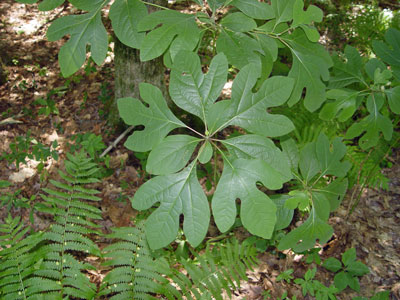DACF Home → Bureaus & Programs → Maine Natural Areas Program → Communities, Plants, and Animals → Rare Plants → Sassafras albidum

Sassafras albidum (Nutt.) Nees
Sassafras
- State Rank: S2
- Global Rank: G5
- State Status: Special Concern
Habitat: Woods and thickets. [Hardwood to mixed forest (forest, upland); Old field / roadside (non-forested, wetland or upland)]
Range: Southern Maine to Michigan and Missouri, south to Florida and eastern Texas.
Aids to Identification: Sassafras is a decidious tree which usually ranges in size from 3-10 m (up to 25 m south of Maine). The alternate, simple leaves are often asymmetrical and are either egg-shaped, 2-lobed, or 3-lobed. The twigs are green and, when crushed, both the twigs and the leaves have a distinctive spicy odor. The bark of a mature tree is deeply furrowed and reddish-brown. The greenish-yellow flowers are unisexual. The carpellate flowers mature as a blue drupe borne on a red pedicel.
Ecological characteristics: In Maine, sassafras tends to form the understory in mixed oak/maple/white pine upland stands and occurs at edges or where the forest is more open.
Phenology: Flowers April - June. Fruits August - October.
Family: Lauraceae
Synonyms: None noted.
Known Distribution in Maine: This rare plant has been documented from a total of 12 town(s) in the following county(ies): Cumberland, Oxford, York.
Reason(s) for rarity: At northern limit of range; not rare southward.
Conservation considerations: Tolerates human-caused or natural disturbance. Restricted statewide to extreme southern Maine. Although populations there may have been reduced by residential or commercial land conversions, maintaining the remaining populations may be feasible with only a small amount of local attention.